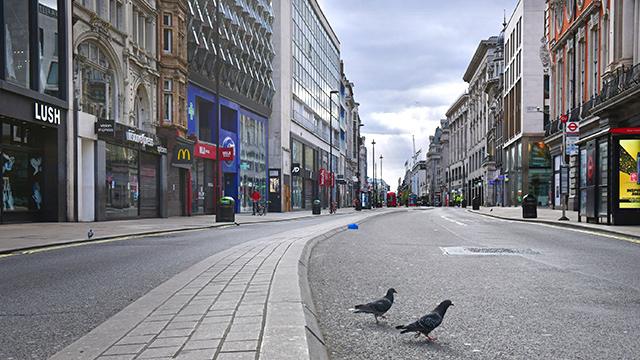Coronavirus: When will we know if the UK lockdown is working?
- Published
- comments

It's two weeks since Boris Johnson announced the UK's lockdown, and there are signs the rate of infection is starting to slow, though not deaths.
While the number of people dying in hospital with coronavirus is doubling every few days, the figures for confirmed cases and hospitalisations are slowing down.
The daily death total will follow suit, scientists say. But they warn we could still see record highs in the coming days.
No let-up in the numbers of new deaths
Over the past three weeks, the number of new deaths reported has been doubling every three-and-a-half days. The graph below shows this, with the daily numbers as red bars, against a straight black line which represents that constant, regular rate of doubling.

Not every day's figures are exactly on trend. There have been dips on Mondays (for example 23 and 30 March) when the weekend's figures were being reported, with sharp rises in the following days.
In terms of numbers, what matters "is the overall trend, rather than the day-to-day figures", says James Gill, a lecturer at Warwick Medical School. That trend is a worrying one: if it continued, we would expect to see more than 1,000 deaths a day very soon and 2,000 a day later this week.
Why does it take so long to see an improvement in the number of deaths?
Even if all infections had stopped the day after lockdown, we would still be seeing new deaths reported a month later.

It takes time for an infection to develop into symptoms or a life-threatening illness, and it takes time for them to be treated, even if that treatment eventually ends in death.
And after that, deaths have to be recorded and reported, a process that can take more days, and weeks in some cases. That reporting delay means that, when we do pass the peak, we may not see it in the death figures for a few days.
Social distancing was introduced before the lockdown, so there is some hope that the effect of those measures may start to show in the coming weeks. Modellers at the London School of Hygiene and Tropical Medicine estimate that for every four people we met or touched before lockdown, we are only meeting one now, external.
They calculated this could reduce the ability of the virus to reproduce by 75%.
But while the lockdown measures are not yet showing up in the death data, other figures do give clues to their effectiveness.
New cases and hospital admissions are slowing down
Since last weekend, the daily growth in new cases has fallen away from the long-term trend.
In the middle of the week, new cases did start growing again but at a slower pace than before.

The number of new cases could rise again this week, says Prof Keith Neal, an epidemiologist at the University of Nottingham. But that could be because of more testing as opposed to an increase in infection rates.
Until the end of March, testing was largely limited to patients in hospital. As the government tests more and more NHS staff, we should expect to see more confirmed cases.
Prof Neal says we'll only get a clear picture of what's happening "if the government report the number of new confirmed cases in NHS workers separately from cases in patients".
The number of patients in hospital in England with coronavirus has also been growing more slowly than before, in the past week.

These figures for England mask regional variation: the number of people in hospital with Covid-19 in London has started to plateau, but has been growing in the Midlands and the North West in recent days.
Find out how many people have confirmed cases in your area:

Lessons from abroad
China implemented severe lockdowns in Wuhan and Hubei province late in January before it saw 30 deaths. The number of deaths reported each day continued to increase for nearly three weeks but has fallen since then.
Italy's national lockdown began on 8 March. About two weeks after that, the number of deaths started to plateau, with the most recent figures showing a fall.

Like the UK, Italy took measures to stop the spread of the epidemic, such as early, targeted versions in northern Italian towns in late February, before the nationwide lockdown. It is possible that these measures could have started to flatten the curve of deaths before the effects of the wider lockdown were visible.
The trends in numbers of deaths from China and Italy are evidence that efforts to stop the spread of the virus can slow, and eventually reverse, the growth in the number of deaths.
While it takes a long time for a reduction in infections to feed through into a reduction in deaths, the numbers of confirmed cases are already levelling off and the growth in confirmed cases has slowed down.

A SIMPLE GUIDE: How do I protect myself?
AVOIDING CONTACT: The rules on self-isolation and exercise
LOOK-UP TOOL: Check cases in your area
MAPS AND CHARTS: Visual guide to the outbreak
VIDEO: The 20-second hand wash
